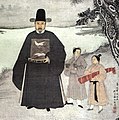Chinese clothing
STOP VANDALIZING WIKIPEDIA!

The clothing of China has varied greatly throughout different periods of time. The wide range of clothing from each era have been imprinted on artifacts, arts and photos across Chinese culture. Each social or historical period brought about a new style. Unlike many other cultures, it did not adopt contemporary fashion styles until much later.
History
Dynastic China
Pre-Qing Dynasty Chinese clothing is broadly referred to as hanfu with many variations such as traditional Chinese academic dress. Depending on one's status in society, each social class had a different sense of fashion.
This section needs expansion. You can help by adding to it. (June 2008) |
Civil and military officials
Chinese civil or military officials used a variety of codes to show their rank and position. The most recognized is the Mandarin square or rank badge. Another code was also the use of colorful hat knobs fixed on the top of their hats. The specific hat knob on one's hat determined one's rank. As there were nine types of hat knobs representing the nine distinctive ranks of the civil or military position. Variations existed for Ming official headwear.


Qing Dynasty (1644–1911)
The rise of the Manchu Qing Dynasty in many ways represented a cultural rupture with the past and new clothing styles were required to be worn by all citizens through laws such as the Queue Orders. A new style of dress, called tangzhuang, included the changshan worn by men and the qipao worn by women. Manchu official headwear differed from the Ming version but the Qing continued to use the Mandarin square.
Republic of China (1911–1949)

The abolition of imperial China in 1912 had an immediate effect on dress and customs. The largely Han Chinese population immediately cut off their queue as they were forced to grow in submission to the overthrown Qing Dynasty. Sun Yat-sen popularised a new style of men's wear, featuring jacket and trousers instead of the robes worn previously. Adapted from Japanese student wear, this style of dress became known as the Zhongshan suit (Zhongshan being one of Sun Yat-sen's given names in Chinese).
For women, a transformation of the traditional qipao (cheongsam) resulted in a slender and form fitting dress with a high cut, resulting in the contemporary image of a cheongsam but contrasting sharply with the traditional qipao.
People's Republic of China (1949–1980)
Early in the People's Republic, Mao Zedong would inspire Chinese fashion with his own variant of the Zhongshan suit, which would be known to the west as Mao suit. Meanwhile, Sun Yat-sen's widow, Soong Ching-ling, popularised the cheongsam as the standard female dress. At the same time, old practices such as footbinding, which had been viewed as backwards and unmodern by both the Chinese as well as Westerners, were forbidden.
Around the Destruction of the "Four Olds" period in 1964, almost anything seen as part of Traditional Chinese culture would lead to problems with the Communist Red Guards. Items that attracted dangerous attention if caught in the public included jeans, high heels, Western-style coats, ties, jewelry, cheongsams, and long hair.[1] These items were regarded as symbols of bourgeois lifestyle, which represented wealth. Citizens had to avoid them or suffer serious consequences such as torture or beatings by the guards.[1] A number of these items were thrown into the streets to embarrass the citizens.[2]
Clothing in contemporary China (1980–Present)
Following the relaxation of communist clothing standards in the 1980s, Chinese fashion grew closer to that of the rest of East Asia. Contemporary urban clothing seemed to have developed an obsession with brand names. In major urban centres, especially Shanghai, an increased western look is preferred, and there is an emphasis on formal wear over casual wear for adults on the streets. Teenagers prefer brand names. Children usually wear clothes decorated with cartoon characters.
However, there is also effort by some to revive traditional clothing forms such as the hanfu by the hanfu movement. At an Asia-Pacific Economic Cooperation summit in Shanghai in 2001, the host presented silk-embroided tangzhuang jackets as the Chinese traditional national costume.
Image gallery
-
Jade burial suit fashion
-
Making of Qing era clothes
-
Emperor Wu of Jìn, by Yan Liben (600–673)
-
Tang Dynasty court ladies from the tomb of Princess Yongtai in the Qianling Mausoleum, near Xi'an in Shaanxi
-
Official Song Dynasty portrait painting of Empress Cao, wife of Emperor Renzong of Song
-
Ming Dynasty Empress Xiao'an
-
A typical headdress of the Ming Empress, decorated with blue colored cloisonné leaf patterns
-
A Ming Dynasty portrait of the Chinese official Jiang Shunfu (1453–1504). The decoration of two cranes on his chest are a Mandarin square "rank badge" that indicate he was a civil official of the first rank.
-
Detail of Jiang Shunfu's rank badge
-
The Qing Dynasty Qianlong Emperor in ceremonial armour on horseback
-
The Qing Dynasty Tongzhi Emperor in common clothes
-
A Hong Kong woman in a traditional qipao (cheongsam) with an over jacket
-
Officers of the Chinese Consolidated Benevolent Association in the United States in traditional dress, with riding jackets (馬掛) over changshan.
-
Chinese children in the United States traditional tangzhuang and Qing dynasty-style headwear
-
Chiang Kai-shek (front centre) and Mao Zedong (front right) both dressed in the Zhongshan suit (Mao suit) (1945)
-
A group of hanfu enthusiasts in China, part of the hanfu movement
-
A contemporary hanfu wearer
-
1999 Shanghai street scene
See also
References
External links
this page is not true because it can be eddited.
















